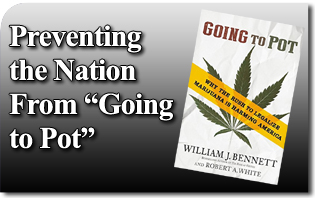 Going to Pot: Why the Rush to Legalize Marijuana Is Harming America by William J. Bennett and Robert A. White is an excellent book about the dangers of marijuana use. The book convincingly demonstrates that marijuana is harmful to individuals, marriages, families and society in general. Marijuana use has moral, physiological, psychological, and economic consequences.
Going to Pot: Why the Rush to Legalize Marijuana Is Harming America by William J. Bennett and Robert A. White is an excellent book about the dangers of marijuana use. The book convincingly demonstrates that marijuana is harmful to individuals, marriages, families and society in general. Marijuana use has moral, physiological, psychological, and economic consequences.
Such dangers are largely ignored by those obsessed with legalizing or decriminalizing marijuana use. Currently several states have legalized recreational marijuana. Half now allow for medical marijuana usage. Yet others have decriminalized its possession at least in small quantities.
For this reason, it is important to be armed with the facts about marijuana. Going to Pot is an excellent resource with plenty of statistics and studies to prove the harmful effects of marijuana use.
The two authors of Going to Pot are very qualified to speak on the subject. Dr. William Bennett was Secretary of the Department of Education during the Reagan administration and the Drug Czar during the administration of George H.W. Bush. Looking at the legal aspects of the problem, Robert A. White is an attorney with over forty years of experience, including as a U.S. District Attorney in New Jersey.
Their arguments do much to destroy the myths around marijuana use. It should be noted that marijuana usage is constantly changing. The book gives the latest data and reasons for avoiding the weed.
The idea that smoking it today is just like that of the sixties is particularly revealing. The authors point out that the active ingredient in marijuana is THC, which stands for tetrahydrocannabinol. The marijuana that was used in the sixties had a THC level of 3–5%. The cultivated and refined marijuana of today has a THC level from 9.6 to 30+%. As a result, today’s marijuana has a far greater impact on the mind and body.
In a June 3, 2014 column, liberal New York Times columnist, Maureen Dowd described her hellish nightmare experience of taking one bite out of a marijuana candy bar in Colorado. Her account alone should be enough to create a healthy and radical avoidance of marijuana use, legal or otherwise.
The authors cite numerous studies about the addictive aspect of marijuana. As with any vice, the more it is committed the more one craves a more intense experience. The mind or body, after repeated use, becomes addicted. Joe Califano, founder and chairman of The National Center on Addiction and Substance Abuse at Columbia University, wrote: “Whatever the substance, brains of repeat drug users are ‘rewired’, becoming predisposed to cravings… The more frequently and longer an addict uses drugs, the more drugs he or she needs to create the high.”
Studies also show that 70% of teens admitted to a substance abuse program claiming marijuana as their primary drug of abuse. Factors that influence the behavior of youth are perceived risk, social acceptability, availability, and cost. Legalized marijuana removes healthy restraints for youth who are still in the developmental stage of formulating their convictions and behaviors. If something is legal then it is perceived to be morally acceptable. This message of acceptance might be seen, for example in Denver, where there are more marijuana shops than Starbucks.
Other bad effects of marijuana use have been linked to what can become a permanent drop in IQ, or a diminishing of judgment, coordination and motor skills.
Regarding medical marijuana, the authors point out that its description as therapeutic is not accurate since those who use it fail to follow standard established medical practice. In states where medical marijuana is allowed, it is not prescribed. Rather, a sort of permission slip is signed by the dispensing physician. Neither is it dosed. Legitimate prescription medications are prescribed by a licensed physician and are dispensed by a pharmacist with a determined dosage level depending on a variety of medical factors. Thus, medical marijuana is not really medical since it makes the patient both doctor and pharmacist.
The argument is often used that the war on drugs has been a failure. Dr. Bennett indicates that the opposite is true. In 1979 over 14 percent of America’s population abused drugs. Due to America’s war on drugs that number declined by 1992 to 6 percent.
Going to Pot is highly recommended. It contains a tremendous amount of material that should convince any reasonable person that marijuana is a dangerous drug to be avoided at all costs. It will also help the reader see the dangerous cliff toward which society is headed because of the greatly increased use of this dangerous drug by the young, adults and elderly.
To conclude, despite the very good medical, psychological, and social reasons why marijuana usage is bad, the most important is the moral reason. The deliberate impairing of the mind or harming of the body is a grave sin against the Fifth Commandment that protects the lives of all. Such abuse offends God and leads to a society that quickly goes to pot.

